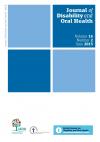Journal of Disability and Oral Health

- Cover Date:
- June 2015
- Print ISSN:
- 1470-8558
- Vol:
- 16
- Issue:
- 2
Moving away from fee for service is a necessary step in the evolution of dental practice for patients with special healthcare needs
Moving away from fee for service is a necessary step in the evolution of dental practice for patients with special healthcare needs
RP Nalliah, LE Simon, V Allareddy, S Rampa and V Allareddy
Abstract
In Australia, Canada, Britain and the United States (US), the dental billing system is largely fee-for-service. In the US the Current Dental Terminology (CDT) codes are used to help dentists report the procedures they performed on patients. There is a trend to view dentistry as a specialised ï¬eld of medicine, however, the billing systems in the US are in conflict with this trend. Providing dental treatment in silos and failing to integrate medical management of certain patients could be a major access to care issue. The authors of this article believe fee for service acts as a disincentive for dentists to treat their patients holistically, because billable codes are strictly procedure based. Instead, there is an inherent incentive to deliver billable procedures.
Key words: Access to care, fees
- Article Price
- £15.00
- Institution Article Price
- £
- Page Start
- 59
- Page End
- 62
- Authors
- RP Nalliah, LE Simon, V Allareddy, S Rampa, V Allareddy
Articles from this issue
- Title
- Pg. Start
- Pg. End
- The challenges of oral health data collection among people with intellectual disabilities: results from Special Olympics Australia
- 43
- 48
- A service review investigating dental extractions in a specialist screening clinic prior to intravenous bisphosphonates for patients with cancer
- 54
- 58
- Moving away from fee for service is a necessary step in the evolution of dental practice for patients with special healthcare needs
- 59
- 62
